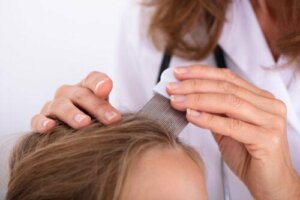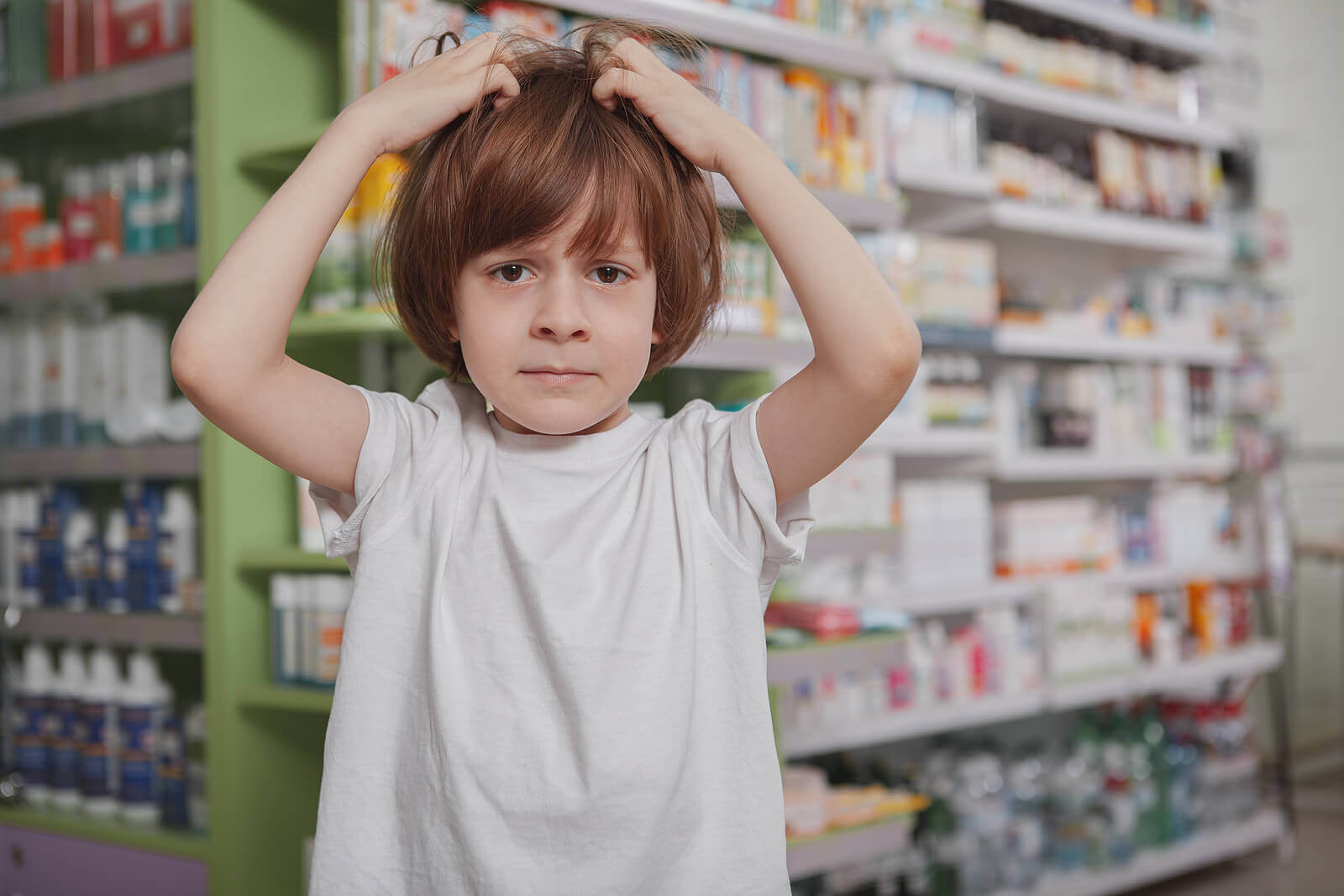Pediculosis in Children: What You Need to Know About Lice


Written and verified by the dermatologist Maria del Carmen Hernandez
Pediculosis in children is one of the most common parasitic infections and is a worldwide public health problem. It’s most prevalent in children between the ages of 5 and 13 years, mostly girls.
There’s no mandatory reporting when it comes to lice, but it’s an infection that crosses all socioeconomic barriers. In turn, it’s more common in warmer months and humid temperatures.
What are lice?
Lice are parasites that are highly particular to the scalp and produce pediculosis in children and adults alike. According to the Center for Disease Control and Prevention, there are three varieties of lice:
- Pediculus humanus capitis (head louse).
- Pthirus pubis (crab louse or pubic louse).
- Pediculus humanus (body louse).

Head and body lice differ in comparison to pubic lice due to their larger size (1 to 3 millimeters). The head louse can spend its entire life on the head of the host, i.e. it’s an obligate parasite. This is why they feed exclusively on the blood of the host’s head. However, without consuming blood, they can survive for only one or two days.
What is the life cycle of head lice?
Lice have a life span of about 28 days. In their evolution, they go through 3 phases:
- Nit or egg: The eggs adhere to the base of the hair, adjacent to the scalp. However, when nits are found beyond the scalp, it’s because the hair has been growing. Egg-laying usually takes place at the temples, behind the ears, and on the nape of the neck.
- Nymph: Nymphs resemble adult lice, but are smaller. However, within 7 days of hatching, they become adults.
- Adult louse: An adult louse can lay up to 10 eggs in a day.
The time it takes for a louse to develop has implications when it comes to treatment.
How do lice spread?
The main route of transmission of this pathology is by close head-to-head contact. Therefore, when children are playing, the probability of contagion is higher.
Transmission through objects is a rare exception and epidemiologically irrelevant, according to studies published in the International Journal of Dermatology.
If they’re away from the head of a host, lice die within 2 days at most. However, they stop infecting after only a few hours. In addition, lice don’t jump or fly, contrary to what many believe.
Read also: 7 Tips for Preventing and Dealing with Lice
Symptoms of pediculosis in children
The main and best-known symptom is itching of the scalp. Consequently, intense scratching can lead to secondary bacterial infections and complications like impetigo or pyoderma.
The itching is a consequence of the allergic reaction to the parasite’s saliva. This is why it occurs 4 to 6 weeks after infection. The diagnosis is confirmed by the observation of at least one louse at the time of visual inspection.
An excoriated “lice rash” can be even observed in the nape of the neck region, which may be subject to secondary infection by Staphylococcus Aureus or Streptococcus. On palpation, the lymph nodes may be swollen.

Treatment to eradicate pediculosis in children
There are several options for carrying out the treatment of pediculosis. Of these, physical removal by means of a fine-tooth comb is the most popular. Other options include the following:
- Permethrin 1%: This is a synthetic pyrethroid that you apply to wet hair after washing it without conditioner. You then allow it to act for 10 minutes before rinsing. You should repeat the application in 7-10 days.
- Malathion 0.5%: You should apply this lotion to dry hair, leave it to air dry, and rinse it off after 8-12 hours. It has great ovicidal power in one application, however, you must reapply after 7 days. Just keep in mind that you should never use it in children under 2 years of age.
- Lindane 1%: Available as a shampoo, it should be left on the scalp for no more than 4 minutes and reapplication should take place in 9 to 10 days. It’s a second-line treatment that’s contraindicated for use in newborns and should be used with extreme caution in children and people weighing less than 110 pounds.
- Benzyl alcohol 5%: Approved for use in children older than 6 months, it should be left to act for 10 minutes and repeat the application in 7 days.
It’s not just a scalp infection
The prognosis of head lice infections is good. However, it can cause children social embarrassment, missing school, and social distress. Children with head lice often feel uncomfortable interacting with their peers or receive unpleasant comments from them.
Pediculosis in children is one of the most common parasitic infections and is a worldwide public health problem. It’s most prevalent in children between the ages of 5 and 13 years, mostly girls.
There’s no mandatory reporting when it comes to lice, but it’s an infection that crosses all socioeconomic barriers. In turn, it’s more common in warmer months and humid temperatures.
What are lice?
Lice are parasites that are highly particular to the scalp and produce pediculosis in children and adults alike. According to the Center for Disease Control and Prevention, there are three varieties of lice:
- Pediculus humanus capitis (head louse).
- Pthirus pubis (crab louse or pubic louse).
- Pediculus humanus (body louse).

Head and body lice differ in comparison to pubic lice due to their larger size (1 to 3 millimeters). The head louse can spend its entire life on the head of the host, i.e. it’s an obligate parasite. This is why they feed exclusively on the blood of the host’s head. However, without consuming blood, they can survive for only one or two days.
What is the life cycle of head lice?
Lice have a life span of about 28 days. In their evolution, they go through 3 phases:
- Nit or egg: The eggs adhere to the base of the hair, adjacent to the scalp. However, when nits are found beyond the scalp, it’s because the hair has been growing. Egg-laying usually takes place at the temples, behind the ears, and on the nape of the neck.
- Nymph: Nymphs resemble adult lice, but are smaller. However, within 7 days of hatching, they become adults.
- Adult louse: An adult louse can lay up to 10 eggs in a day.
The time it takes for a louse to develop has implications when it comes to treatment.
How do lice spread?
The main route of transmission of this pathology is by close head-to-head contact. Therefore, when children are playing, the probability of contagion is higher.
Transmission through objects is a rare exception and epidemiologically irrelevant, according to studies published in the International Journal of Dermatology.
If they’re away from the head of a host, lice die within 2 days at most. However, they stop infecting after only a few hours. In addition, lice don’t jump or fly, contrary to what many believe.
Read also: 7 Tips for Preventing and Dealing with Lice
Symptoms of pediculosis in children
The main and best-known symptom is itching of the scalp. Consequently, intense scratching can lead to secondary bacterial infections and complications like impetigo or pyoderma.
The itching is a consequence of the allergic reaction to the parasite’s saliva. This is why it occurs 4 to 6 weeks after infection. The diagnosis is confirmed by the observation of at least one louse at the time of visual inspection.
An excoriated “lice rash” can be even observed in the nape of the neck region, which may be subject to secondary infection by Staphylococcus Aureus or Streptococcus. On palpation, the lymph nodes may be swollen.

Treatment to eradicate pediculosis in children
There are several options for carrying out the treatment of pediculosis. Of these, physical removal by means of a fine-tooth comb is the most popular. Other options include the following:
- Permethrin 1%: This is a synthetic pyrethroid that you apply to wet hair after washing it without conditioner. You then allow it to act for 10 minutes before rinsing. You should repeat the application in 7-10 days.
- Malathion 0.5%: You should apply this lotion to dry hair, leave it to air dry, and rinse it off after 8-12 hours. It has great ovicidal power in one application, however, you must reapply after 7 days. Just keep in mind that you should never use it in children under 2 years of age.
- Lindane 1%: Available as a shampoo, it should be left on the scalp for no more than 4 minutes and reapplication should take place in 9 to 10 days. It’s a second-line treatment that’s contraindicated for use in newborns and should be used with extreme caution in children and people weighing less than 110 pounds.
- Benzyl alcohol 5%: Approved for use in children older than 6 months, it should be left to act for 10 minutes and repeat the application in 7 days.
It’s not just a scalp infection
The prognosis of head lice infections is good. However, it can cause children social embarrassment, missing school, and social distress. Children with head lice often feel uncomfortable interacting with their peers or receive unpleasant comments from them.
All cited sources were thoroughly reviewed by our team to ensure their quality, reliability, currency, and validity. The bibliography of this article was considered reliable and of academic or scientific accuracy.
- Janniger CK, Kuflik AS. Pediculosis capitis. Cutis. 1993 Jun;51(6):407-8. PMID: 8519181.
- Leung AK, Fong JH, Pinto-Rojas A. Pediculosis capitis. J Pediatr Health Care. 2005 Nov-Dec;19(6):369-73. doi: 10.1016/j.pedhc.2005.07.002. PMID: 16286223.
- Fölster-Holst R. Itch Management in Childhood. Curr Probl Dermatol. 2016;50:173-91. doi: 10.1159/000446090. Epub 2016 Aug 23. PMID: 27578087.
- De Maeseneer J, Blokland I, Willems S, Vander Stichele R, Meersschaut F. Wet combing versus traditional scalp inspection to detect head lice in schoolchildren: observational study. BMJ. 2000 Nov 11;321(7270):1187-8. doi: 10.1136/bmj.321.7270.1187. PMID: 11073509; PMCID: PMC27522.
- Nenoff P, Handrick W. Pediculosis capitis. Wenn’s auf Kinderköpfen kribbelt [Pediculosis capitis]. MMW Fortschr Med. 2014 Aug 21;156(14):49-51. German. doi: 10.1007/s15006-014-3342-x. PMID: 25195409.
- Takano-Lee M, Edman JD, Mullens BA, Clark JM. Transmission potential of the human head louse, Pediculus capitis (Anoplura: Pediculidae). Int J Dermatol. 2005 Oct;44(10):811-6. doi: 10.1111/j.1365-4632.2005.02418.x. PMID: 16207180.
This text is provided for informational purposes only and does not replace consultation with a professional. If in doubt, consult your specialist.








